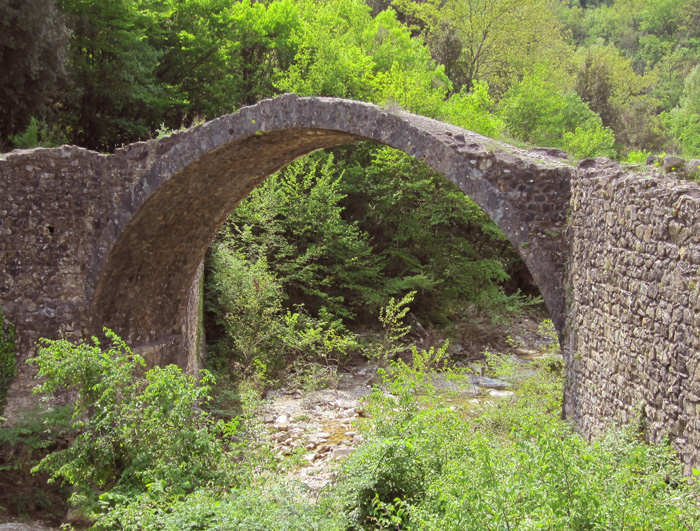Ponte della Pia |
| Along the ancient road that connects Siena to Massa Marittima, in the vicinity of Rosia, there is a single-arched humpback bridge, that over the centuries has helped people cross the stream below it. Its structure is quite plain and without parapets, for this reason, even though it is still possible to walk on it, you need to be very careful. The bridge was built in the Roman times and later reconstructed in the year 1000, tradition says that Pia de' Tolomei – the unhappy and beautiful bride of Nello d'Inghiramo de' Pannocchieschi - walked over this bridge to go into exile in the Castello di Pietra, located in Maremma. Pia de' Tolomei was a Sienese woman allegedly murdered by her husband, Paganello de' Pannocchieschi, who had her thrown from a window in Maremma. The event is also contained in the 5th Canto of Dante Alighieri's Purgatorio: “Ah, when you return to the world, / and are rested after your long journey”/ a third spirit, followed on the second: / “Remember me who am La Pia; / Siena made me, Maremma undid me: / he knows, who having first pledged himself to me, / wed me with his ring”. The biography of this Sienese noblewoman who lived in 1200, has been pieced together starting from Dante's Canto. Pia de' Tolomei was the first wife of Nello de' Pannocchieschi, the Lord of Castel di Pietra and Magistrate of Volterra and Lucca, Captain of the Tuscan Guelphs in 1284 and lived until at least 1322. Tolomei was probably killed by her husband, who made her throw out a window of the Castello di Pietra after imprisonment for a presumed unfaithfulness or simply because he wanted to marry Margherita Aldobrandeschi, Countess of Sovana and Pitigliano. A lot of books have been written on Pia, some of them are history-based, others take into account also the Tuscan folktales; almost all of these texts anyway agree on the fact that she came from the Guastelloni Family of Siena, a peerage of nobles and bankers and married Baldo d'Aldobrandino de' Tolomei, before getting married later to Nello de' Pannocchieschi. She became a widow in 1290 after giving birth to two children. From this moment on, things get more complicated: some versions affirm that she wasn't able to get pregnant and give a proper successor to Nello and this basically could be the reason behind her murder, others state the woman cheated her jealous consort and finally that he wanted to marry Margherita... Probably the truth will always be buried, but a lot of people swear, they have seen the quiet ghost of the noblewoman crossing the bridge of Rosia, in black nights without moon, completely dressed in white, surrounded by a feeble light and the face covered by a veil. Could it be that Pia is still waiting to ascend into Heaven? After all, she was the one who confessed to Dante, that nobody from her family would have prayed for her... |
|||
Pia de' Tolomei asks for Dante's prayers when he encounters her waiting to enter Purgatory among souls who died suddenly and unprepared. "Son Pia, Siena mi fé, disfecemi Maremma." ("I am Pia. Siena made me; Maremma unmade me.") Purg. V, 130–136. |
|||
| "Oh, when you will have come back into the world And you will have rested from the long walk, follow the third spirit, after the second, remember me, I am Pia, born in Siena and died in Maremma. How I died, he, who first gave me his ring And then married me, knows." |
|||
| Pia's story is the theme of an opera by Donizetti. Dante Gabriel Rossetti painted Pia in 1868.[1] Dante Gabriel Rossetti, Pia de' Tolomei |
|||
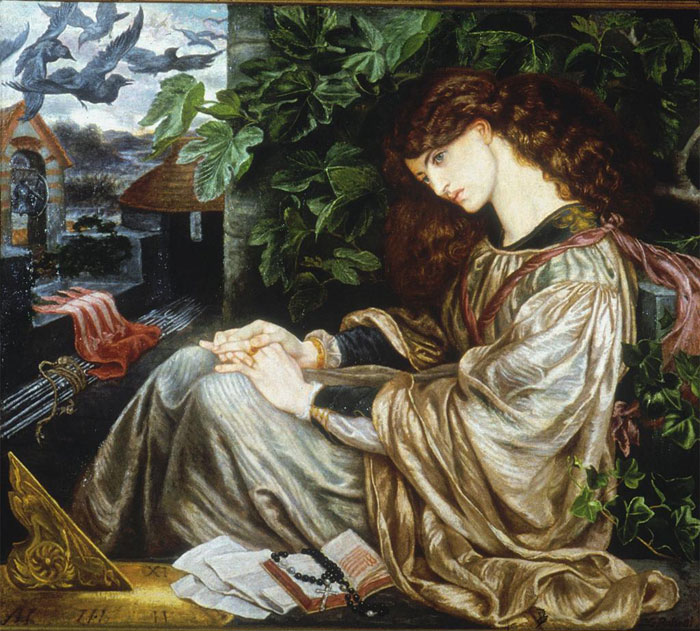 |
|||
Dante Gabriel Rossetti, Pia de' Tolomei (1868–1880) (model: Jane Morris), Spencer Museum of Art, University of Kansas, Lawrence, KS, USA
|
|||
 |
||||
| Palazzo Tolomei, Siena | ||||
[1] [2] [3] [3] Photo by licensed under the Creative Commons Attribution-Share Alike 3.0 Unported license. |
||||
| This page uses material from the Wikipedia articles Pia de 'Tolomei, Dante Gabriel Rossetti, and Sistine Chapel, published under the GNU Free Documentation License. | ||||
| The Eremo di Rosia is situated near the medieval bridge over the River Rosia, called Ponte della Pia. The church, entitled to holy Antonio and Luca, was probably built with only nave's system but today is remained only the presbytery's and external wall's part. From the main road, the hermitage is located along a cobblestoned Roman road surrounded by woods. During the Middle Ages this road was a spur off the Via Francigena, the route from Canterbury to the holy places in Rome. The hermitage Eremo di Rosia was situated just a little off the road but close enough to be visited by pilgrims. It is cut into the hillside and consisted of a Gothic church, the hermits' convento or friary, places for working and storage, a cloister (clausura) roofed over on two sides and a channel for bringing fresh water to the residents. Like the legends of Lecceto and Centumcelle, Rosia lays claim to a visit from St. Augustine during the year of 387 on his way from Milan to Rome. |
||||
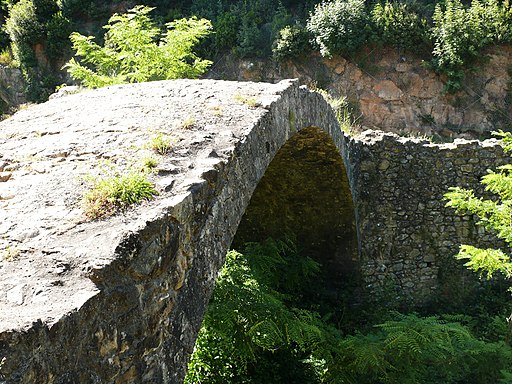 |
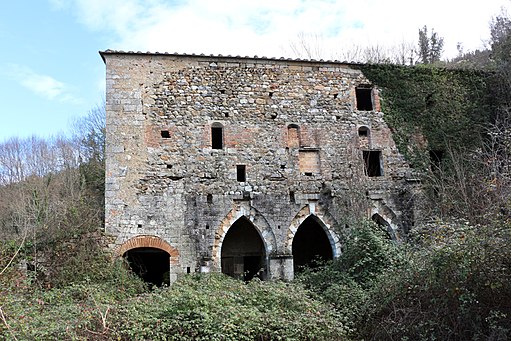 |
 |
||
Ponte della Pia - Molli
|
Eremo di Santa Lucia (Rosia) | Eremo di Santa Lucia (Rosia), particolare degli archi
|
||
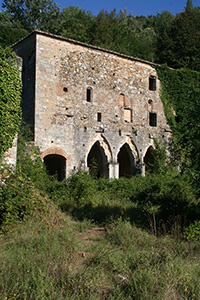 |
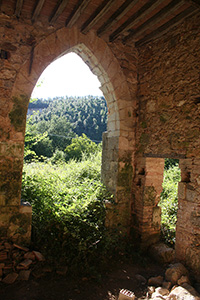 |
|||
Il torrente Rosia e il Ponte della Pia.
|
Eremo di Santa Lucia (Rosia) | Eremo Rosia | ||
| By 1575 the hermitage (eremo) had been made a branch of the large Augustinian community in Siena. In 1638, only two men remained there, and Santa Lucia at Rosia closed. The ruins of the church still reflect its elegant simplicity, a hallmark of Augustinian life, in the one standing wall of alternating white and red marble in the Pisa-Lucchese style. The convent has been much transformed during the years it functioned as a farmhouse. Completely abandoned for years now, its most interesting pieces have been taken away and placed in the home of the owner of the land. However, three gothic arches and the traces of a number of windows remain to give evidence of what it once looked like. |
||||
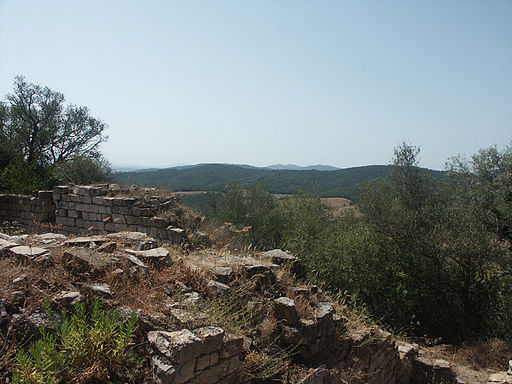 |
||||
Castel di Pietra in Gavorrano, where Pia de Tolomei was pushed to her death
|
||||
Trekking in Toscana | Monteriggioni – Ponte della Pia
|
 |
Castel di Pietra, lapide apposta sulle mura del castello nel 1921 in occasione del VI centenario della morte di Dante Alighieri (Foto: Aerospike)
|

